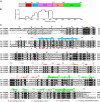Plant actin-binding protein SCAB1 is dimeric actin cross-linker with atypical pleckstrin homology domain
- PMID: 22356912
- PMCID: PMC3320945
- DOI: 10.1074/jbc.M111.338525
Plant actin-binding protein SCAB1 is dimeric actin cross-linker with atypical pleckstrin homology domain
Abstract
SCAB1 is a novel plant-specific actin-binding protein that binds, bundles, and stabilizes actin filaments and regulates stomatal movement. Here, we dissected the structure and function of SCAB1 by structural and biochemical approaches. We show that SCAB1 is composed of an actin-binding domain, two coiled-coil (CC) domains, and a fused immunoglobulin and pleckstrin homology (Ig-PH) domain. We determined crystal structures for the CC1 and Ig-PH domains at 1.9 and 1.7 Å resolution, respectively. The CC1 domain adopts an antiparallel helical hairpin that further dimerizes into a four-helix bundle. The CC2 domain also mediates dimerization. At least one of the coiled coils is required for actin binding, indicating that SCAB1 is a bivalent actin cross-linker. The key residues required for actin binding were identified. The PH domain lacks a canonical basic phosphoinositide-binding pocket but can bind weakly to inositol phosphates via a basic surface patch, implying the involvement of inositol signaling in SCAB1 regulation. Our results provide novel insights into the functional organization of SCAB1.
Figures







Similar articles
-
Phosphatidylinositol 3-phosphate regulates SCAB1-mediated F-actin reorganization during stomatal closure in Arabidopsis.Plant Cell. 2022 Jan 20;34(1):477-494. doi: 10.1093/plcell/koab264. Plant Cell. 2022. PMID: 34850207 Free PMC article.
-
Phosphatidic acid inhibits SCAB1-mediated F-actin bundling in Arabidopsis.Plant Signal Behav. 2023 Dec 31;18(1):2092346. doi: 10.1080/15592324.2022.2092346. Epub 2022 Jun 26. Plant Signal Behav. 2023. PMID: 35757987 Free PMC article.
-
The plant-specific actin binding protein SCAB1 stabilizes actin filaments and regulates stomatal movement in Arabidopsis.Plant Cell. 2011 Jun;23(6):2314-30. doi: 10.1105/tpc.111.086546. Epub 2011 Jun 30. Plant Cell. 2011. PMID: 21719691 Free PMC article.
-
Novel structural insights into F-actin-binding and novel functions of calponin homology domains.Curr Opin Struct Biol. 2008 Dec;18(6):702-8. doi: 10.1016/j.sbi.2008.10.003. Epub 2008 Nov 13. Curr Opin Struct Biol. 2008. PMID: 18952167 Review.
-
The complexity and diversity of the actin cytoskeleton of trypanosomatids.Mol Biochem Parasitol. 2020 May;237:111278. doi: 10.1016/j.molbiopara.2020.111278. Epub 2020 Apr 28. Mol Biochem Parasitol. 2020. PMID: 32353561 Review.
Cited by
-
Phosphatidylinositol 3-phosphate regulates SCAB1-mediated F-actin reorganization during stomatal closure in Arabidopsis.Plant Cell. 2022 Jan 20;34(1):477-494. doi: 10.1093/plcell/koab264. Plant Cell. 2022. PMID: 34850207 Free PMC article.
-
Controlling the Gate: The Functions of the Cytoskeleton in Stomatal Movement.Front Plant Sci. 2022 Feb 23;13:849729. doi: 10.3389/fpls.2022.849729. eCollection 2022. Front Plant Sci. 2022. PMID: 35283892 Free PMC article. Review.
-
Phosphatidic acid inhibits SCAB1-mediated F-actin bundling in Arabidopsis.Plant Signal Behav. 2023 Dec 31;18(1):2092346. doi: 10.1080/15592324.2022.2092346. Epub 2022 Jun 26. Plant Signal Behav. 2023. PMID: 35757987 Free PMC article.
-
Structural features of LC8-induced self-association of swallow.Biochemistry. 2013 Sep 3;52(35):6011-20. doi: 10.1021/bi400642u. Epub 2013 Aug 21. Biochemistry. 2013. PMID: 23914803 Free PMC article.
-
Respiratory Syncytial Virus Matrix (M) Protein Interacts with Actin In Vitro and in Cell Culture.Viruses. 2018 Sep 30;10(10):535. doi: 10.3390/v10100535. Viruses. 2018. PMID: 30274351 Free PMC article.
References
-
- Blanchoin L., Boujemaa-Paterski R., Henty J. L., Khurana P., Staiger C. J. (2010) Actin dynamics in plant cells: a team effort from multiple proteins orchestrates this very fast-paced game. Curr. Opin. Plant Biol. 13, 714–723 - PubMed
-
- Hussey P. J., Ketelaar T., Deeks M. J. (2006) Control of the actin cytoskeleton in plant cell growth. Annu. Rev. Plant Biol. 57, 109–125 - PubMed
-
- Thomas C., Tholl S., Moes D., Dieterle M., Papuga J., Moreau F., Steinmetz A. (2009) Actin bundling in plants. Cell Motil. Cytoskeleton 66, 940–957 - PubMed
Publication types
MeSH terms
Substances
Associated data
- Actions
- Actions
LinkOut - more resources
Full Text Sources
Molecular Biology Databases

